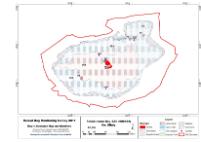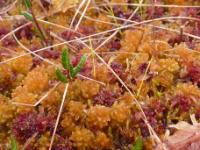Raised Bog Restoration Project
The National Parks and Wildlife Service are working with Coillte on an EU LIFE project that aims to identify best practice for restoring raised bogs in Ireland. More information can be found in Brochure for Raised Bog Restoration Project LIFE09 222 or on the project website at www.raisedbogrestoration.ie.
Raised Bog Monitoring Survey
The National Raised Bog Monitoring Survey commenced in July 2011. A selection of 12 designated raised bogs, within 10 designated sites, are currently being surveyed. The main objective of the survey is to report on the conservation status of 4 Habitats Directive Annex I habitats within these bogs, as follows:
- 7110 Active Raised Bogs
- 7120 Degraded Raised Bogs still capable of natural regeneration
- 91D0 Bog Woodland
- 7150 Depressions on peat substrates of the Rhynchosporion
As part of the assessment changes in habitat extent, quality or intensity of pressures from previous Raised Bog Monitoring Project 2004-5 (Fernandez et al. 2005) will be assessed. This new survey results will be used to complete national assessments of the conservation status of each habitat type.
 |
 |
 |
| Bog pool on raised bog | Map of Raheenmore Bog | Sphagnum sp. (Photos: NPWS) |
The Flora and Conservation Status of Petrifying Springs in Ireland
Petrifying springs are of considerable ecological and hydrogeological interest and are listed as a priority habitat on Annex I of the EU Habitats Directive. They occur where lime-rich water emerges from below ground and deposits calcium carbonate or 'tufa' on the ground surface. Tufa appears as a whitish, crunchy coating on plants and on the ground surface. It may become consolidated into a porous rock, often forming a cascade down a hillside.
The flora of petrifying springs is usually dominated by bryophytes such as Palustriella commutata, Bryum pseudotriquetrum, Eucladium verticillatum and Cratoneuron filicinum. As the water disperses below the spring head, it often gives rise to a species-rich flush containing higher plants such as sedges (especially Carex viridula subsp. brachyrrhyncha), common butterwort (Pinguicula vulgaris), grass-of-Parnassus (Parnassia palustris) and bog pimpernel (Anagallis tenella).
 |
 |
| Petrifying spring with Palustriella commutata on the coast near Skerries, Co. Dublin (Photo: Melinda Lyons) | Cascade of tufa with Cratoneuron filicinum near the River Boyne, Co. Meath (Photo: Melinda Lyons) |
'The Flora and Conservation Status of Petrifying Springs in Ireland' is a PhD research study which will investigate the diversity of flora and the contributing environmental factors in a wide range of petrifying spring sites throughout the country. It will ascertain the current conservation status of petrifying springs, elucidate key issues impacting on habitat quality and make recommendations for conservation and future monitoring of this important ecological resource.
This Ph.D. will be undertaken by Melinda Lyons under the supervision of Dr Daniel Kelly, Trinity College Dublin.
NPWS contact: Dr Deirdre Lynn
Project duration: 2010-2013
Turloughs
A multidisciplinary project was awarded to Trinity College Dublin that will integrate hydrological, biological and chemical nutrient data from selected turloughs. The data will be used to develop new models relating hydrology with turlough ecology, thereby providing improved ecological understanding of the main factors and processes affecting turlough biota.This will be used to formulate scientifically sound prescriptions for both monitoring and maintaining the international conservation value of this EU priority habitat.
For further information download a detailed description of the Turlough project ![]() [36KB] or visit the project website.
[36KB] or visit the project website.
Members of Research Branch can be contacted by e-mailing: natureconservation@npws.gov.ie
